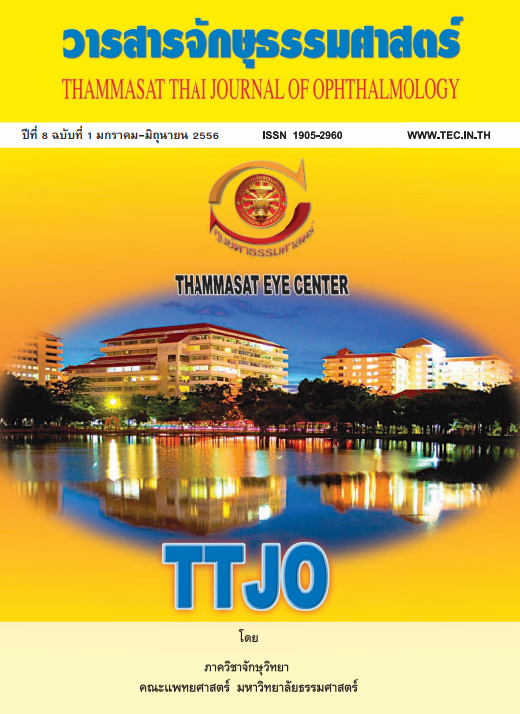ความสัมพันธ์ระหว่างความหนาจอตาของจุดรับภาพกับความไวแสงและการมองเห็นภาพบิดเบี้ยวในตาผู้ป่วยที่มีเยื่อพังผืดที่เกิดเองบนผิวจุดรับภาพ
Main Article Content
Abstract
วัตถุประสงค์: เพื่อศึกษาหาความสัมพันธ์ระหว่างความหนาจอตาของจุดรับภาพกับความไวแสงและการมองเห็นภาพบิดเบี้ยวในตาผู้ป่วยที่มีเยื่อพังผืดที่เกิดเองบนผิวจุดรับภาพ
รูปแบบการศึกษา: การวิจัยเชิงวิเคราะห์ ณ จุดเวลาใดเวลาหนึ่ง (Analytic Cross-Sectional Studies)
วิธีการศึกษา: ศึกษาในผู้ป่วย Idiopathic epimacularmembrane จำนวน 30 คนนำมาตรวจวัดความหนาของจุดรับภาพด้วยเครื่อง Optical coherence tomography,ตรวจระดับการเห็นภาพบิดเบี้ยวด้วย Amsler chartตรวจค่าความไวของจุดรับภาพโดยเครื่อง Automated Perimetry โปรแกรม 10-2 และ ตรวจ BCVA โดย ETDRS chart แล้วนำมาหาความสัมพันธ์ในตำแหน่งต่างๆ ที่สอดคล้องกัน
ผลการศึกษา: ในบริเวณจุดรับภาพ Central fovea และCentral 5° ค่า macular thickness มีความสัมพันธ์กับค่าlog MAR VA (R2=0.29 และ 0.24) และระดับการมองเห็น metamorphopsia (R2 =0.42 และ 0.28) อย่างมีนัยสำคัญ ทางสถิติ (p>0.05) แต่ไม่มีความสัมพันธ์กับค่า retinalsensitivity อย่างมีนัยสำคัญทางสถิติ (R2 =0.02 และ 0.003, p>0.05) ส่วนในบริเวณจุดรับภาพ Central 5-10°ค่า macular thickness มีความสัมพันธ์กับค่า log MAR VA อย่างมีนัยสำคัญทางสถิติ (R2 =0.15, P< 0.05) และมีความสัมพันธ์กับการมองเห็น metamorphopsia อย่างมีนัยสำคัญทางสถิติเฉพาะตำแหน่ง nasal และ temporal(R2 =0.15 และ 0.20, P< 0.05) แต่ไม่มีความสัมพันธ์กับค่า retinal sensitivity อย่างมีนัยสำคัญทางสถิติ(R2 =0.02, P> 0.05)
สรุป: ในการตรวจประเมินคุณภาพการมองเห็นในผู้ป่วยที่เป็น idiopathic epimacular membrane จะใช้การตรวจ BCVA และการตรวจมองเห็นภาพบิดเบี้ยวด้วย Amsler chart เป็นการตรวจเบื้องต้นเพื่อเป็นข้อมูลในการวางแผนดูแลรักษาผู้ป่วย แต่อาจยังไม่สามารถประยุกต์ใช้การตรวจวัดค่าความไวแสงของจุดรับภาพโดยเครื่อง Automated Perimetry โปรแกรม 10-2 มาพิจารณาร่วมด้วยได้
Correlation of Macular Thickness with Retinal Sensitivity and Metamorphopsia in Patients with Idiopathic Epimacular Membrane
Abstract
Objective: To study the correlation of macular thickness with the retinal sensitivity and metamorphopsia in patients with idiopathic epimacular membrane
Study design: Analytic cross-sectional study
Method: Thirty patients with idiopathic epimacular membrane were evaluated the macular thickness by optical coherence tomography, the metamorphopsia grading by Amsler chart, the retinal sensitivity by
automated perimetry program 10-2 and the best corrected Visual acuity by the ETDRS chart. Themacular thickness was determined and correlated with the metamorphopsia grading, the retinal sensitivity and the logMAR BCVA following the corresponding area.
Result: In the central fovea and central5°area there were significant correlation between the macular thickness with the LogMAR BCVA (R2 =0.29 and0.24) and the metamorphosia grading (R2=0.42 and 0.28) (p<0.05) but not significant correlation with theretinal sensitivity (R2=0.02 and 0.003, p>0.05).Whilein the central10° area there was significant correlationbetween the macular thickness with the LogMAR BCVA (R2=0.15, p<0.05) and the metamorphosia grading (only in the nasal and temporal side of the fovea) (R2=0.15 and 0.20, p<0.05) but not significant correlation with the retinal sensitivity (R2=0.02 and 0.003, p>0.05).
Conclusion: The visual acuity and the metamorphopsia grading by Amsler chart were the proper basic exam for evaluation the visual function and management plan in the patients with idiopathic epimacular membrane. But it may not be use the applied automated perimetry program 10-2 to evaluate these patients.


